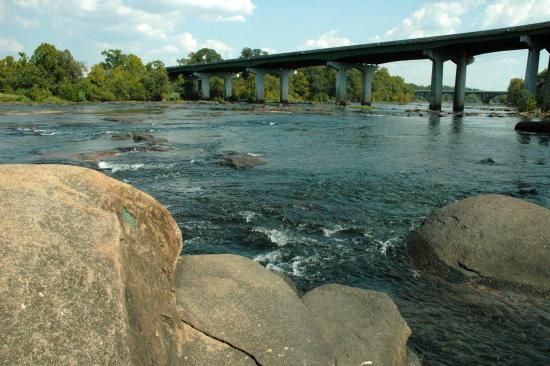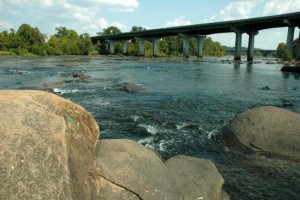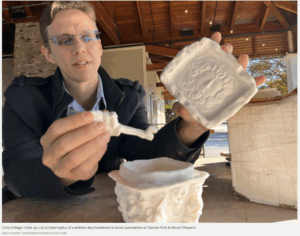SOUTH CAROLINA: Did Sherman Dump Munitions Cache in Congaree?
In the next few weeks, SCE&G contractors will begin digging up and removing 74 “metallic objects” the power company previously identified in the river muck at the Senate Street boat landing, company officials said Tuesday.
No one knows for sure what the metal objects are, but there are historical reports indicating they could be explosive materials left from Gen. William T. Sherman’s march through Columbia in 1865. Consultants recently found evidence that seized Confederate munitions were dumped in the river by the Union general’s troops during the burning of Columbia 150 years ago.
Contractors from Tennessee with experience in handling explosives will oversee the work and detonate any bombs that might still pose a threat, SCE&G officials said.
The work is the first phase of an $18.5 million company project to excavate gooey, toxin-tinged coal tar that oozed into the Congaree decades ago from power plants. The project could take three years.
The overall plan is being revised, and SCE&G now is unlikely to rely on a temporary stone dam to hold back the river while cleanup work occurs, according to the company, which is paying for the project. The overall cleanup job, which will excavate coal tar from the river bed, is expected to begin in May.
But SCE&G’s Thomas Effinger said major cleanup work can’t occur until the question about buried Civil War ordnance is answered. The initial effort could take as few as two to three weeks, barring complications. The area to be excavated will be protected by sandbags, but as of Tuesday, was not underwater.
Effinger said the material might not be Civil War ordnance. It could be hubcaps, for instance, he said. Or the material could be Civil War ordnance that is not rigged to detonate, he said. Most likely the metal objects are not dangerous explosives, he said.
“We don’t expect to find that, but we are going to be prepared in case we do,” said Effinger, director of environmental services for SCANA, SCE&G’s parent company. “What (contractors) do, they’ll do it safely.”
EOTI, a Knoxville, Tenn., company experienced in dealing with explosives, will assess whether the material is a threat and decide the next course, Effinger said. That likely would involve placing a cover over any explosives consultants find, then detonating the material in place. The cover would keep the explosion contained to protect the public and the surrounding environment, Effinger said.
The work will involve sifting through about 4 to 7 feet of soil and digging up the objects buried below, Effinger said. The site will be fenced off and the Senate Street boat landing will be closed to the public, according to plans. Signs will be placed in the river warning boaters to steer clear of the work area, company officials said.
Columbia Mayor Steve Benjamin said city police will patrol the area to keep people out. Work is planned for 7 a.m. to 6 p.m. on weekdays until it is finished. The mayor said the idea is to protect the public, as well as any historical artifacts that might be dug up. The power company is working with historic preservationists to protect artifacts that are not dangerous.
“Souvenir hunters are not welcome,” Benjamin said.
The work plan, revealed by SCE&G in an interview with The State newspaper, is part of a revised plan to clean up the Congaree coal tar.
In announcing plans to begin the initial cleanup work at the Senate Street boat landing this month, SCE&G said Tuesday that it now does not plan to build a temporary rock dam in the river to hold back the water as overall coal tar cleanup work goes on.
Instead, the company would rely on sandbags to hold back smaller sections of the river, Effinger said. When one section is done, the sandbags would be moved to another area and work would begin again.
He said details are not final and need approval from federal authorities.
State and federal regulators were concerned that the temporary dam could erode the riverbanks and increase flood threats on the West Columbia side of the Congaree by pushing too much water in that direction.
The U.S. Army Corps of Engineers, which must permit the work, also was concerned that the dam walls could be overtopped by the river, which could scatter boulders used to create the big structure. The dam was projected to be about 14 feet above the water’s surface along the Columbia side of the river between Gervais and Blossom streets.
A Corps official familiar with the project was unavailable for comment Tuesday.
“At its biggest point, it would have covered about one-third of the width of the river,” Effinger said of the dam. “With this approach, it is going to be smaller and targeted.”
Benjamin said he’s comfortable with the latest plan. The main issue is to clean up the river, one of Columbia’s signature waterways, he said. The major cleanup work would be staged from the area where the metal objects are to be excavated, according to plans.
“We have three beautiful rivers that make up this city and this region,” Benjamin said. “This is something that’s got to be done.”
WHAT LIES BENEATH?
On Feb. 17, 1865, Gen. William T. Sherman’s Union army stormed and burned Columbia after shelling it from afar as they headed north after taking Savannah.
An inventory of the rebel ordnance and ordnance stores captured that day lists:
▪ 1.2 million ball cartridges
▪ 100,000 percussion caps
▪ 6,000 unfinished arms
▪ 4,000 bayonet scabbards
▪ 3,100 sabers
Some of those weapons have long been believed to be at the bottom of the river. Through the years, fishermen and swimmers have found some munitions. And in the 1930s, a large cache was salvaged from the sandy bottom. But how much history is buried under the tar and its condition remain mysteries.
–thestate.com




